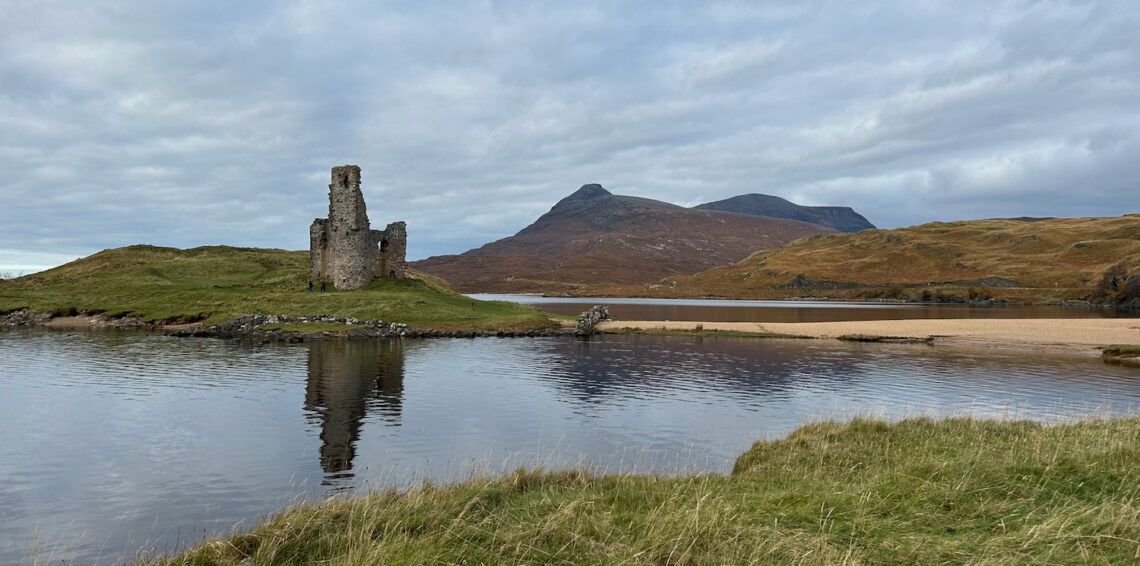
Ardvreck Castle
The last time we were up in the north-west of Scotland was about 15 years ago, to catch a ferry from Ullapool to Stornoway on the Isle of Lewis. I remember the long drive to the ferry terminal, the shops and cafes clustered around the harbour, and then looking back at the mainland as the ship headed out into the Minch, wondering what those mountains were that were disappearing into the dusk.
Last week we went up to Wester Ross and Sutherland to take a closer look. Colin had some research to do for a painting, and he needed to get an idea of the lie of the land while at the same time catching the last of the autumn colour.
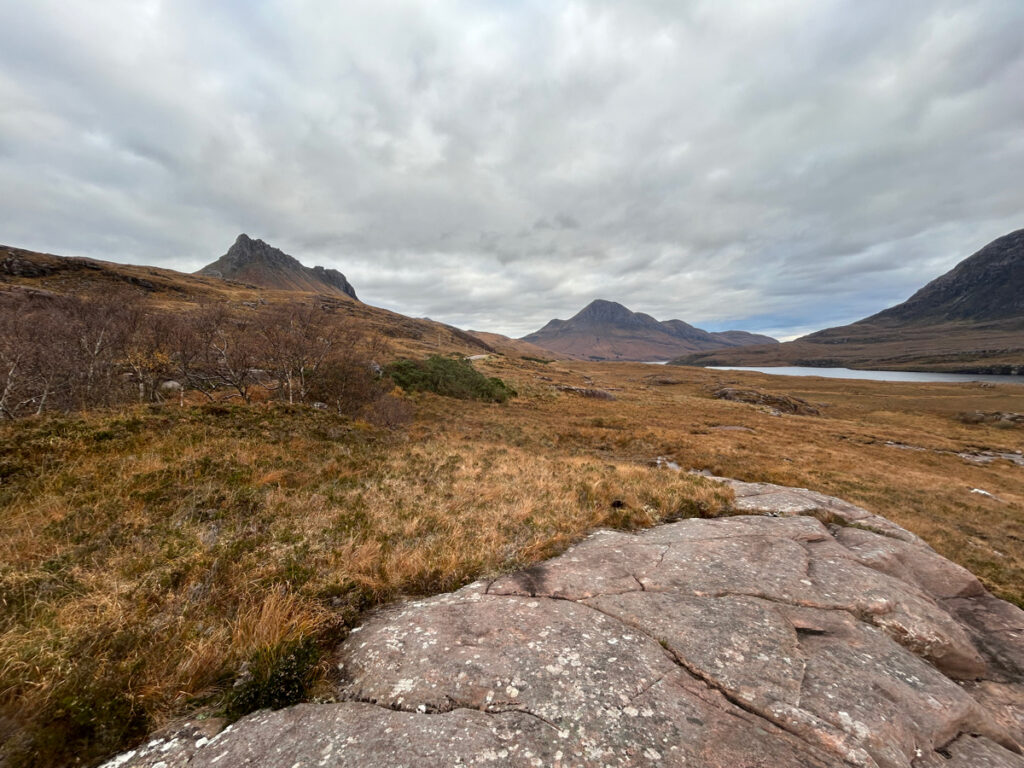
What an extraordinary landscape this is: similar to Orkney in that it has few trees, but there’s a slightly surreal sense of height and exposure. Peaty bog, holed with lochans and punctured here and there by outcrops of pinkish-grey rock, stretches away in all directions beneath a huge dome of sky. Red deer, exactly the same colour as the burnished-bronze vegetation, seemed to emerge out of the ground and vanish back into it at will.
But it was the mountains that drew our eyes: monstrous shapes punching up from the earth with their shattered ridges or rounded whale-back outlines, lurking in the not-quite-there region of bluish-grey distance and then suddenly heaving up alongside you, so that you’re staring up at rock faces that look like the ramparts of Norse gods. Even their names have power: Suilven, Stac Pollaidh, Canisp, Quinag.
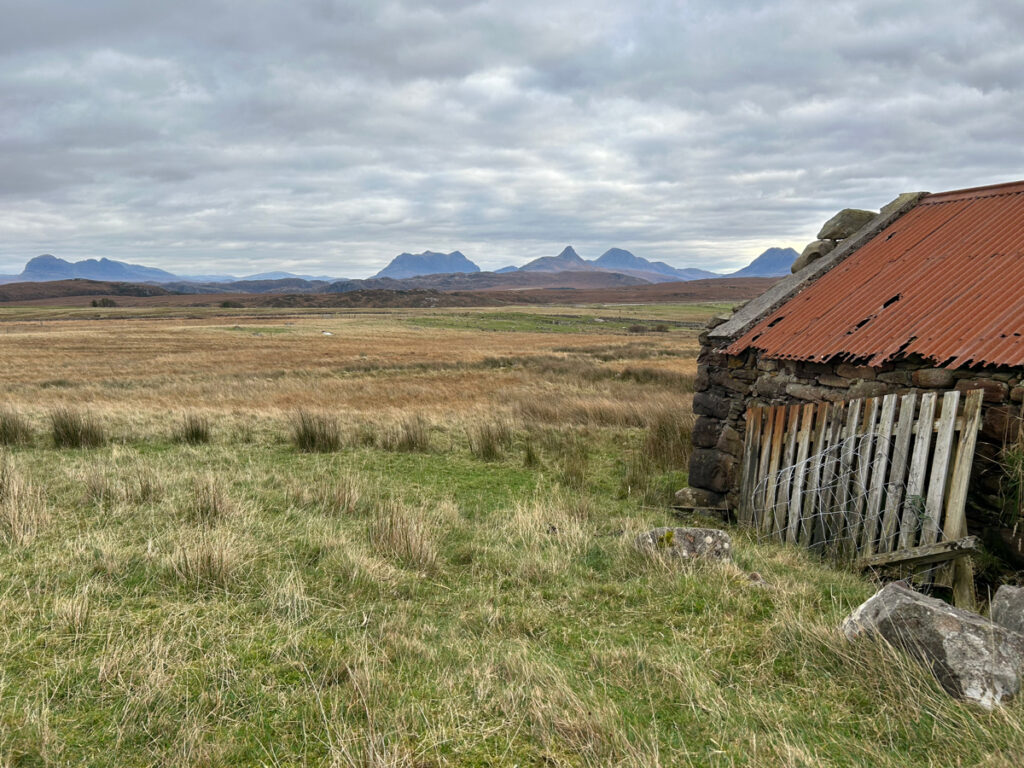
We’d caught the weather conditions just right: very little wind, and cloud that was high enough to stay above the tops, although it didn’t disperse as the forecast had promised. The landscape had a dull glow about it, like a dying fire, and every so often the stillness was broken by a stag roaring.
We were far enough north to visit Ardvreck Castle, a place I knew only from photos in books and online. A picturesque ruin, it guards a small peninsula on the shore of Loch Assynt; bare hills loom to the south and east, while the loch stretches away in a crooked finger to the north-west, narrowing eventually into the River Inver which flows out to sea.

Early in the 15th century, the lands of Assynt were given by Roderick Macleod of Lewis to his second son, Tormod. In time, they were inherited by Angus Mor Macleod, who is thought to have built a simple three- or four-storey stronghold at Ardvreck (in Gaelic, Ard Bhric, meaning speckled or dappled headland).
The original structure, which contained a great hall, was enhanced, a century or so later, by Donald Ban Macleod, who added a tower and vaulted cellars. An information sign near the castle explains: ‘Even after Donald Ban’s improvements, Ardvreck was still small, requiring other buildings around it to house kitchens, servants’ quarters and stables.’

The lower part of the tower, circular in plan, contained a spiral stair. Above it were two rooms, each with a fireplace. An illustration on an information board (below) gives an idea of its original appearance

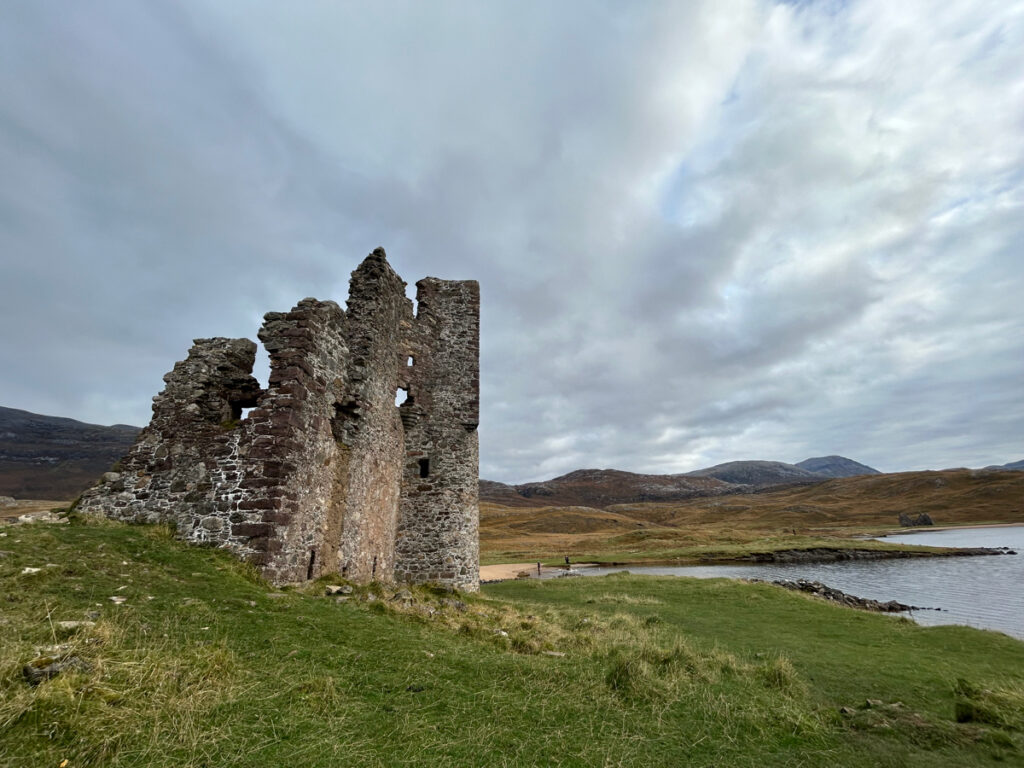
I was interested to read that the castle once had a kitchen garden. Here, of all places, where there’s so little shelter, and the ground is either waterlogged or stony! But Canmore notes that ‘beside Loch Assynt and near Elphin are outcrops of limestone rock and the soil is unusually fertile, a fact appreciated by farmers since prehistoric times.’ It’s true that a cluster of chambered cairns has been noted between nearby Inchnadamph and Ledmore Junction, and there’s one on a knoll overlooking the castle peninsula itself.
Ardvreck Castle has witnessed a good deal of violence, resulting either from disputes between quarrelsome branches of the Macleods or clashes with their traditional enemies. It also witnessed a significant event in Scotland’s history. In 1650, after fleeing from his defeat by the Covenanters at the Battle of Carbisdale, the Royalist leader James Graham, Marquis of Montrose, was imprisoned at Ardvreck Castle and later taken to Edinburgh for execution.
One version of the tale claims that Montrose was tricked into entering the castle and then betrayed to his enemies, while another says that he was captured by Neil Macleod of Assynt and taken there by force. Either way, it is likely that he was held prisoner in one of the small cellars beneath the castle, which are now open to the elements.
In 1672, the Macleods were forced to yield their lands to the Mackenzies of Wester Ross, following a 14-day siege. But for one reason or another, Ardvreck Castle must have seemed an inhospitable place, because Frances, the wife of Kenneth Mackenzie of Assynt, persuaded her husband to build a more comfortable dwelling at the head of the loch. Calda House was commissioned in 1726, but the family was facing financial ruin and it was abandoned soon afterwards; to prevent the house from falling to the Earl of Sutherland, Mackenzie supporters looted and burned it.
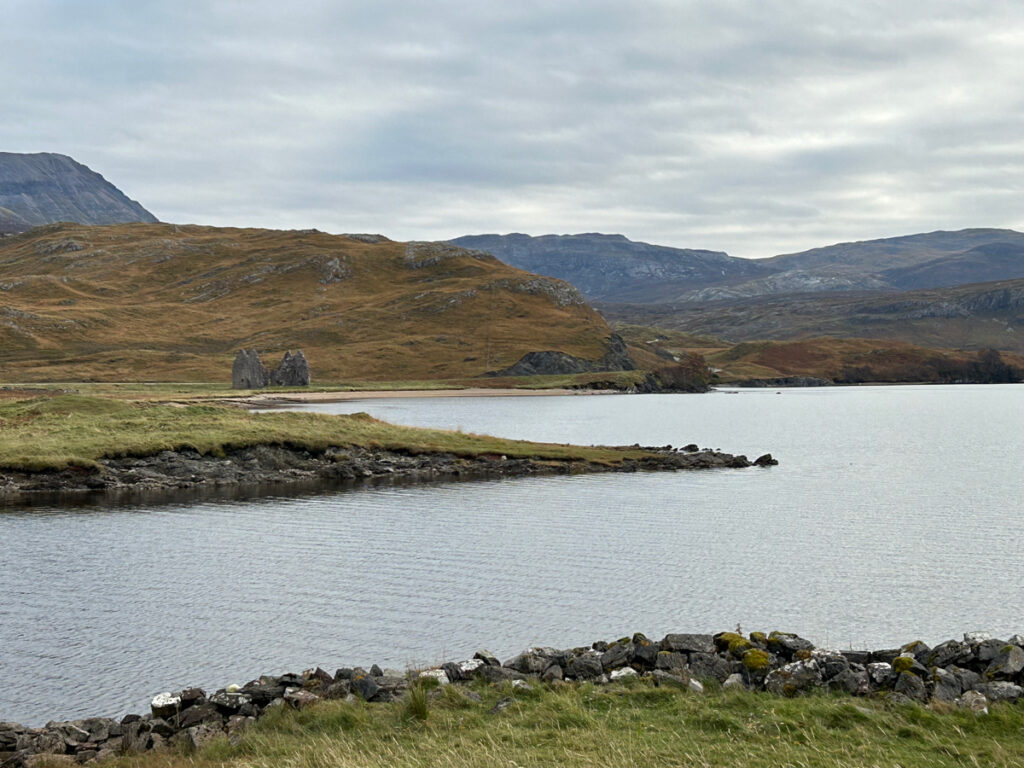
Above: looking south, with the remains of Calda House on the shore

Ardvreck seems to be noted for its ghostly inhabitants. The cries of a weeping woman have been linked with the tale of a daughter of a Macleod chief who threw herself into the loch after being tricked by her father into marrying the Devil, in a pact to save the castle. There’s another version of this story, too: instead of drowning, the woman transformed herself into a mermaid or a selkie and took refuge in an underwater cave; when the water level rises, so it is said, the ‘Mermaid of Assynt’ is shedding tears for the life she lost on land.
There is, however, no identity attached to the ghost of a tall man dressed in grey who has been seen in the tower, apparently staring down at the ground.
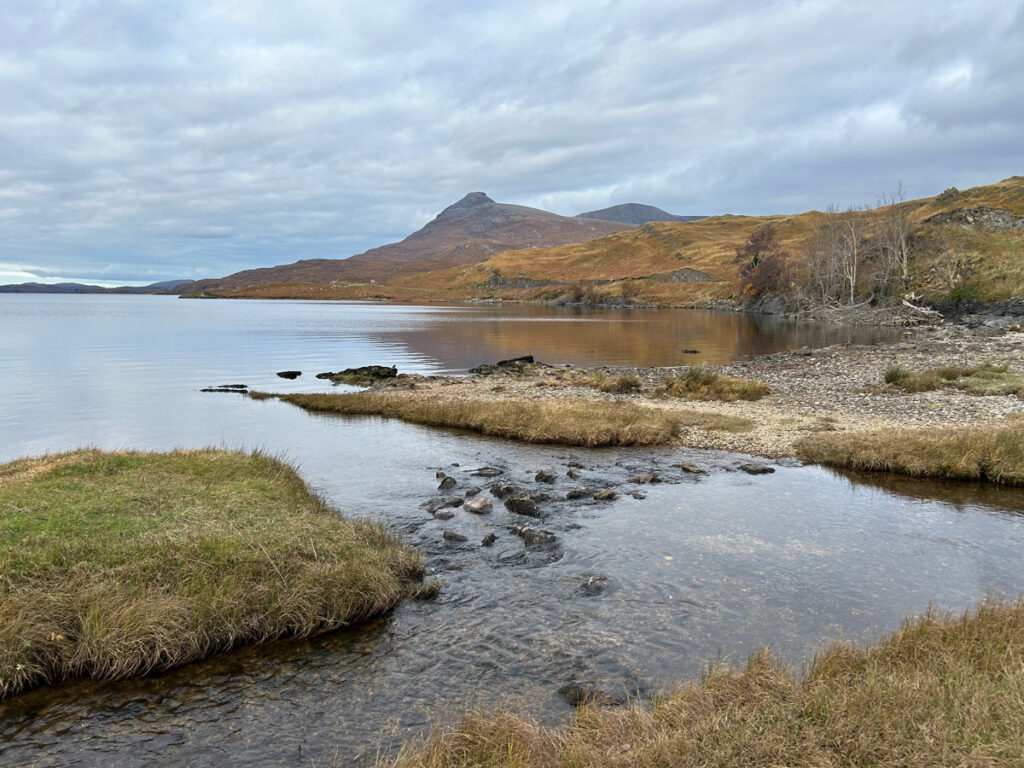
Looking north-west down the loch
With a good few cars in the car park and a handful of people wandering around the peninsula, it would have been hard to conjure any ghosts at Ardvreck even if I’d known about them, which I didn’t. However, after glimpsing the dark interior of the vaulted cellars, I took myself back out of the shadow of the tower and down onto the shore. Even on a practical level this must have been a cold place, shielded from the morning sun, damp rising from the loch. I don’t blame Frances Mackenzie for wanting to live somewhere else.
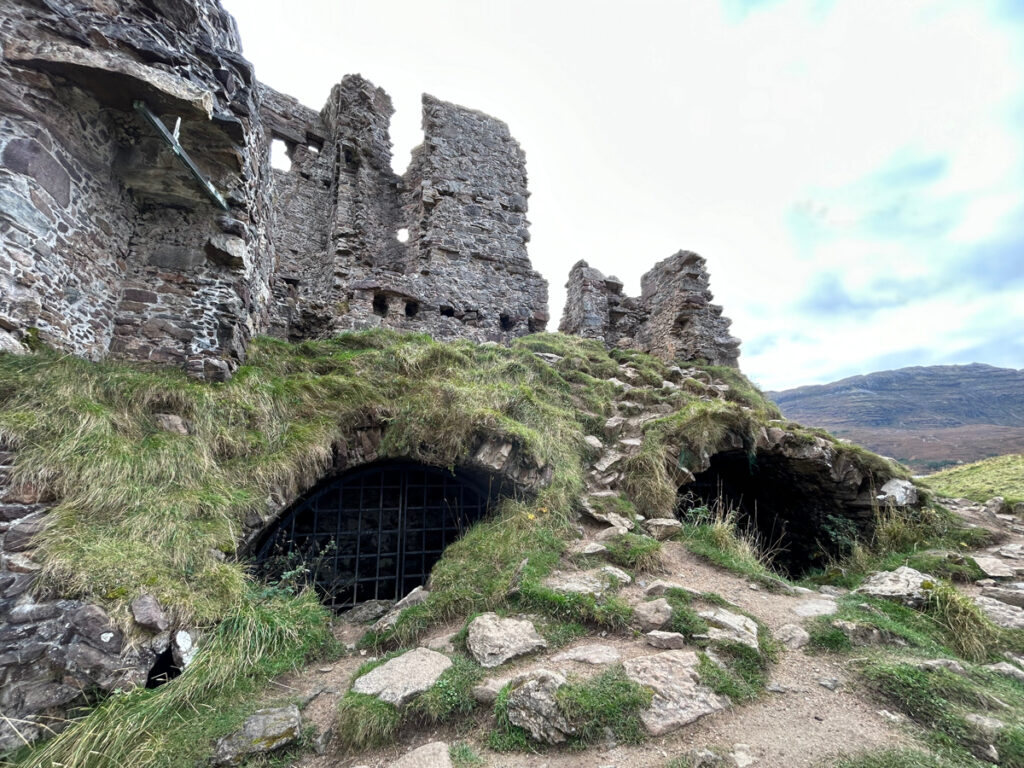
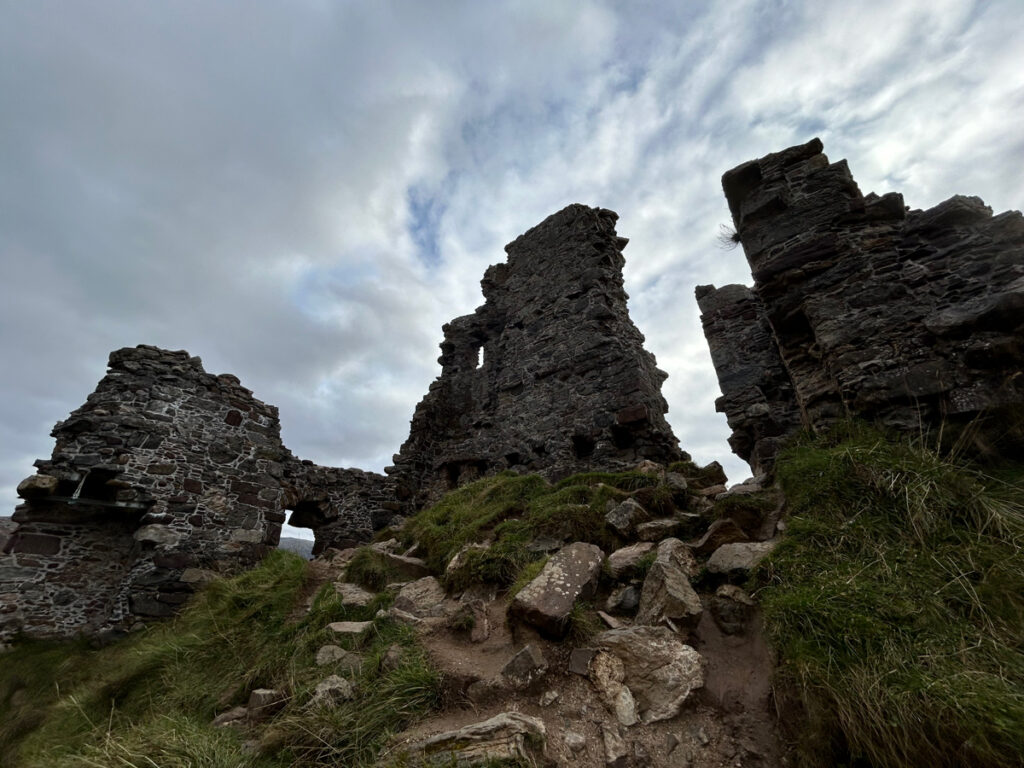
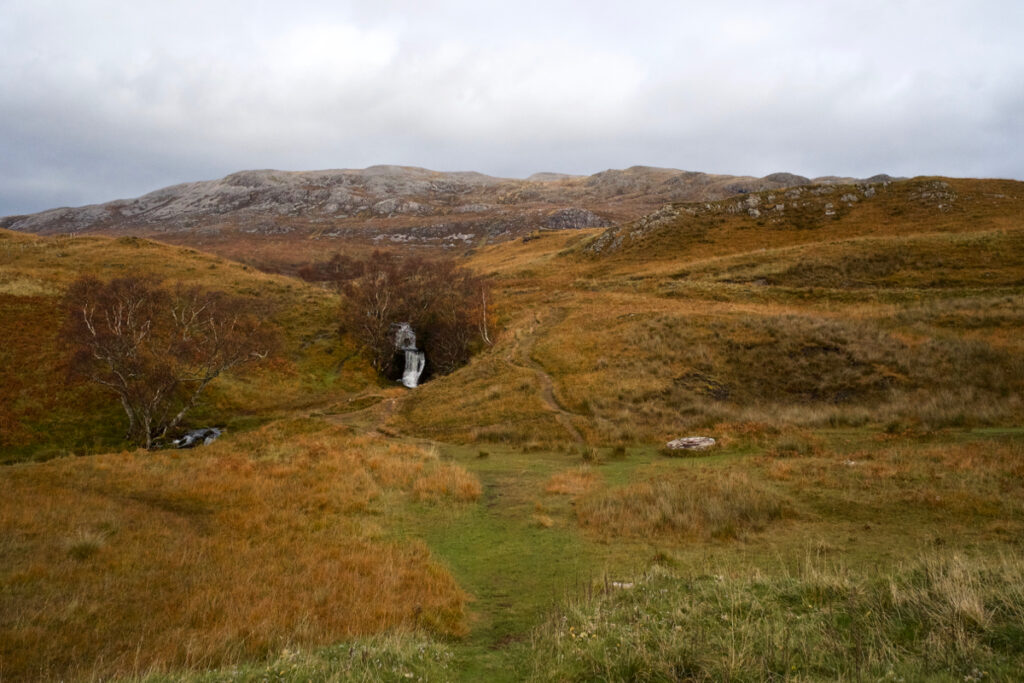
A couple of hundred yards away, near the foot of this waterfall, are the traces of an old mill. A discarded mill stone can still be seen on the ground. In a barn on the peninsula, the grain was winnowed and dried.
Ardvreck seems to have been built primarily as a symbol of possession and status, and it still strikes you with these qualities even though its walls are crumbling and pierced with holes. I’ve explored more ruinous castles than I can possibly remember, but I’ve not come across one that feels more completely abandoned, by human life at any rate. Yet in the soft sand of the shore, fresh deer slots showed that it has visitors of another kind, grazing perhaps in the old garden or drinking from the loch. There may be otters, and possibly divers nesting on the islands in summer. And I can’t imagine a more fitting sound for this landscape than the eerie call of a red-throated diver, the ‘rain-goose’ that was once thought to accompany souls to heaven.
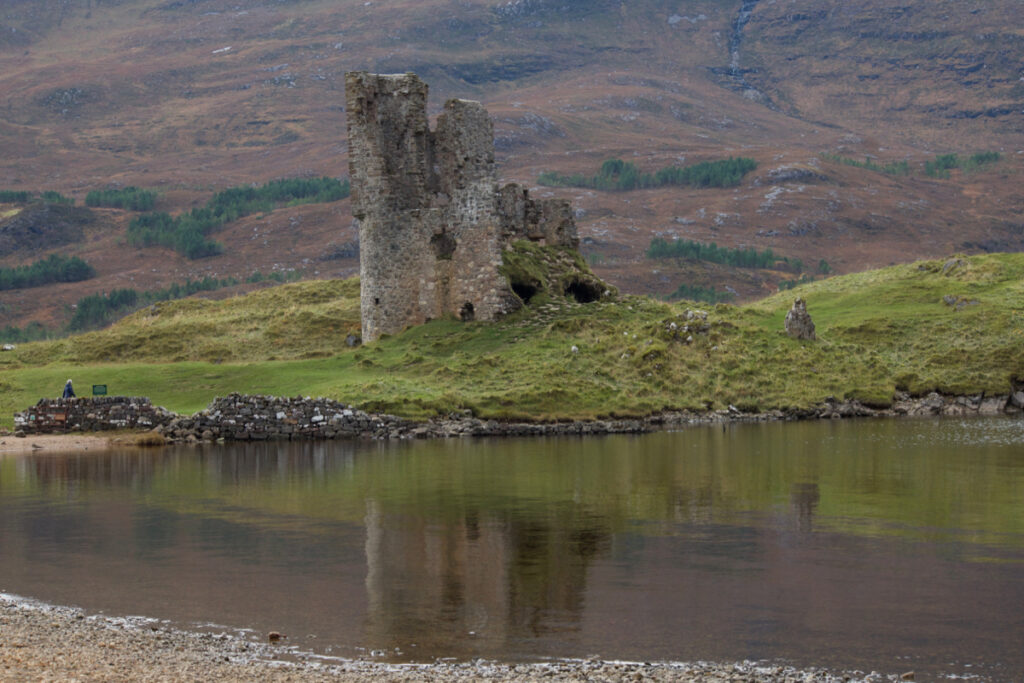
Reference:
- Canmore
- The Castles of Scotland
- The First Marquis of Montrose Society
- Inchnadamph.com
- Spooky Scotland
Photos copyright Jo and Colin Woolf
Colin’s latest paintings can be seen on his website



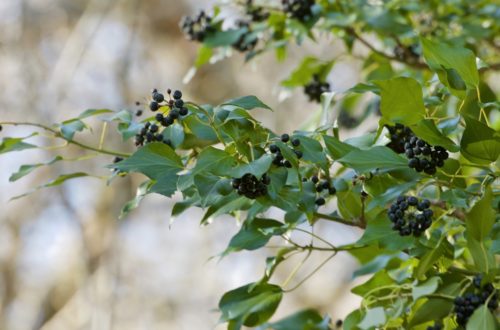
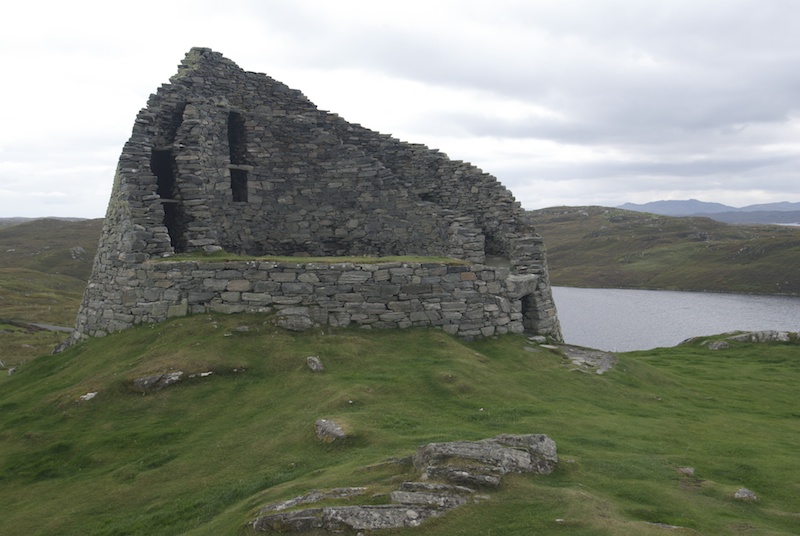
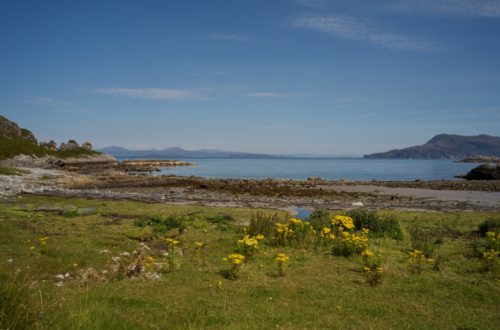
13 Comments
Simon Tough
Great piece! I loved stopping here few years back…a very atmospheric place…def felt something around that ruin!
Jo Woolf
Thank you, Simon. Oh, did you? That’s interesting. It certainly has a presence in the landscape – must have looked magnificent when it was first built.
Finola Finlay
What a wildly romantic place – but I’m with Frances on the comfort. And Colin’s art – wow! What a talented duo.
Jo Woolf
I agree with you there, Finola. My bones ache just at the thought of living there, and with the wailing ghost as well I’m sure Frances was glad to have somewhere warm and new. Thanks for your lovely comment – I’ll tell Colin!
Ian Douglas
Good informative article, Jo. And the photos are excellent. Thank you – really enjoyed reading it.
Jo Woolf
Thank you, Ian! I’m glad you did. Not knowing much about this area, it was interesting to find out some of its history.
Bob Hay
We visited that bleak lonely ruin years ago Jo and my firm opinion of it is, that no self respecting ghost would’ve wanted to live in any part of it. Place gives me the shivers just thinking back on it. Couldn’t fathom out why anyone would’ve built it in such a remote location in the first place unless in those day it was more wooded.
Jo Woolf
Haha, I know, Bob. That baffled me too, but then I found out about the kitchen garden and it sounds as if the underlying limestone in this part of Assynt made the land more fertile. I came across a detailed geological map, made by Sir John Murray and Laurence Pullar when they did their Bathymetrical survey of the Scottish lochs in the early 1900s, and it shows a fairly thin strip of limestone running from the E end of Loch Assynt down towards Inchnadamph. Elsewhere, granite and gneiss are widespread. I’m reading ‘The Frayed Atlantic Edge’ by David Gange at the moment and he says: ‘gneiss and granite starve the ground into blanket bog.’ As for how wooded the landscape was in those days, some sources suggest that peat bog has existed in these parts (and further north) since the retreat of the last ice sheets. I found these pages interesting: https://www.nts.org.uk/stories/peat-bogs-windows-to-the-past-preserving-the-future and https://www.hebrideansmokehouse.com/hebweb/webpage/131
Deb Vallance
Wonderfully evocative narrative and pictures—thank you!
Jo Woolf
Thank you so much, Deb!
davidoakesimages
My favourite part of Scotland. Ullapool upwards and round the coast to Duncansby and then back down the east coast…just fantastic. Have spent many months there. Scourie was always our favourite pace. Mountain backdrops, sea coast that is magical. Handa Island close by and more taking the trip across. Of all the mountains, it is the distinctive Stac Pollaick that is for me the best climb… not the highest but the views just fabulous. My memories go back to well before I was married and the route involved so many small ferries, now of course replaced by many great bridges, but those ferry crossing added to a magic and a love of ‘the north’ still vivid in my memory today. Sadly, Ardvreck is one location I dont have a pic of…. fate always delivered the worst of the weather when there…honest I tried but failed 🙂
Jo Woolf
It’s such a huge region, David – we want to go back, and explore it with more time on our hands. I’ve heard others say that Scourie is wonderful. I’d also like to climb Stac Pollaidh. Amazing that some of these iconic mountains aren’t even Munros, but they are so compelling to look at. There are some beaches we’d love to explore, too. Will plan to return when the daylight lasts a bit longer!
Bob Hay
Hi Jo. I see from Canmore that two cannons were found inside the ruin and are ‘now in Lochinver’ but
doesn’t say where. Would be interesting to find out where they were made. Wouldn’t surprise me if they’d been originally snaffled from some Spanish wreck from the West Coast.